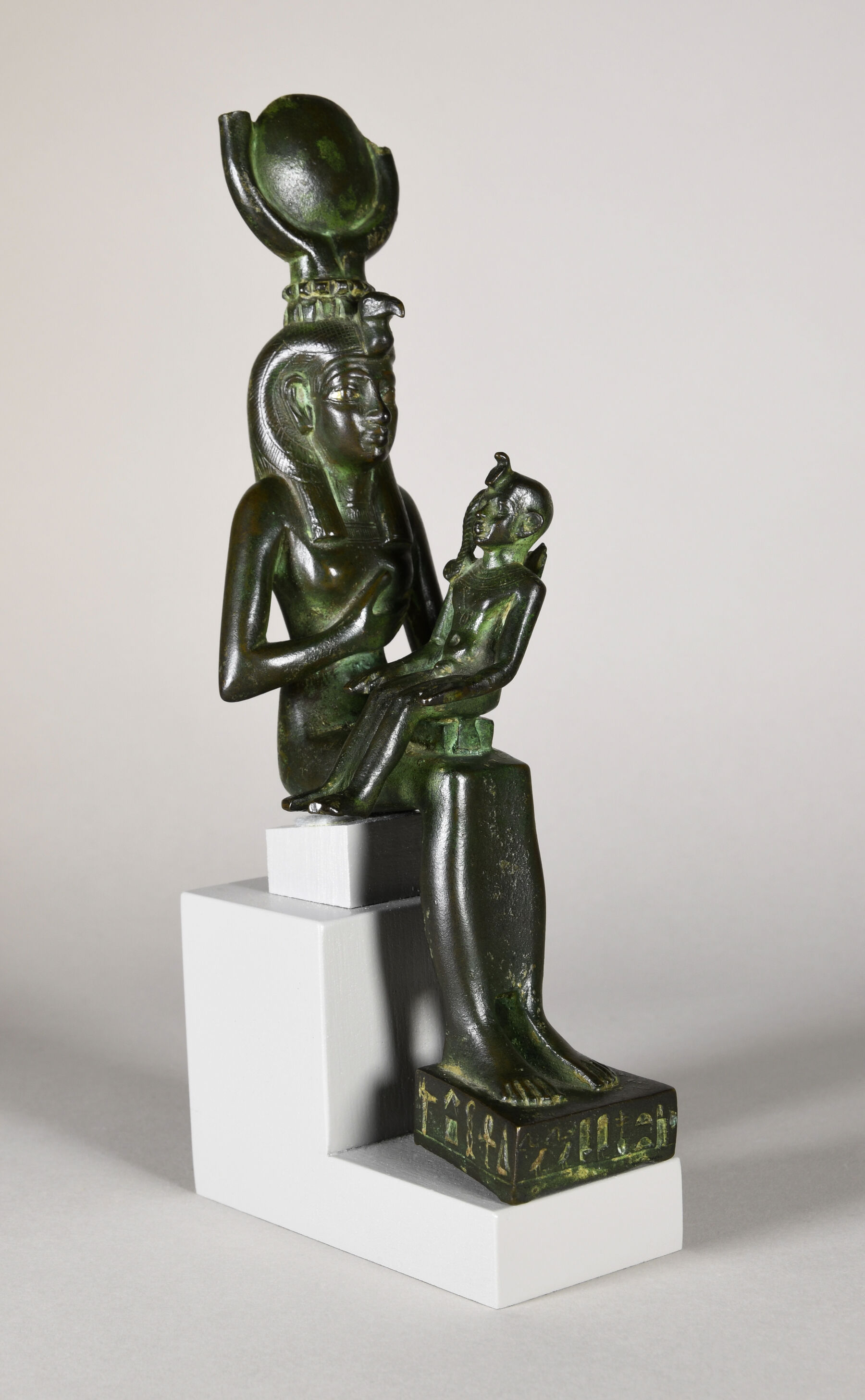This beautiful bronze statue depicts the goddess Isis suckling her young son Horus. Isis was the epitome of a loyal wife and mother. She was also a powerful magician who reassembled the remains of her husband Osiris and brought him to life after he was killed by his jealous brother Seth. Osiris impregnated Isis, and she gave birth to Horus, the god of the sky. She protected and nursed Horus until he grew up and could avenge his father’s death.
Isis’s slightly slanted eyes and upturned lips date the figurine to Dynasty 26.1 The pillow or prong on which the young Horus sits is found on similar bronze statues of that date.2 Isis wears a horn and solar disk crown with a modius of rearing cobras and a vulture headdress with a projecting bird’s head over her long wig. The vulture’s wings curl around her ears, and its tail feathers descend on her back. Her eyes are inlaid with silver. A broad ornamental collar and a long dress adorn her body. Isis supports the naked child with her left arm and offers her breast to him with her right. Horus wears a close-fitting cap with a uraeus. At his right temple is the side lock of youth. The goddess sits on a low-back throne with her feet on a thick base.
An inscription runs around the base. The front socle reads “Isis-Nefertiti,” a rare epithet for the goddess.3 The back socle says, “She(?) of Sais,” which refers to the Late Period merging of Isis and Neith, the titular goddess of Sais.4 The left socle reads, “Giver of life (to?) the mighty Apis,” which evokes Isis’s role as a mother goddess. The donor’s name, “Petetum,” appears on the right socle.5
MH
-
See Hill, Marsha and Deborah Schorsch, eds. 2007. Gifts for the Gods: Images from Egyptian Temples. New Haven and London: Yale University Press.. ↩︎
-
Cf. Isis and Horus, WAM 54.416. ↩︎
-
Translation courtesy of Rune Nyord. ↩︎
-
Leitz, Christian, and Dagmar Budde, eds. 2002-2003. Lexikon der ägyptischen Götter und Götterbezeichnungen, edited by Christian Leitz and Dagmar Budde. 8 vols. Orientalia Lovaniensia Analecta 110-116, 129. Leuven: Peeters, 2002-2003. . ↩︎
-
The reading of the name is unsure because of the lack of the sledge hieroglyph (U15). ↩︎
Bibliography
- Hill and Schorsch 2007
- Hill, Marsha and Deborah Schorsch, eds. 2007. Gifts for the Gods: Images from Egyptian Temples. New Haven and London: Yale University Press.
- Leitz and Budde 2002-2003
- Leitz, Christian, and Dagmar Budde, eds. 2002-2003. Lexikon der ägyptischen Götter und Götterbezeichnungen, edited by Christian Leitz and Dagmar Budde. 8 vols. Orientalia Lovaniensia Analecta 110-116, 129. Leuven: Peeters, 2002-2003.
